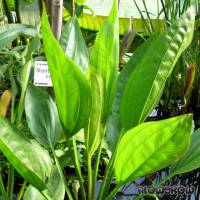



Echinodorus subalatus is quite widely distributed in the tropical regions of America, found in bogs and on riverbanks and lakeshores, temporary ponds and flood plains from Mexico to Argentine. During the rainy season it is often completely submersed. This species is very variable; some of its varieties from Central and party also from South America are thought to be subspecies by some authors (E. subalatus ssp. andrieuxii) or even as distinct species (E. andrieuxii).
E. subalatus is closely related to E. decumbens, E. inpai and E. palaefolius. Like the latter three, the grown emersed plant of E. subalatus has longitudinal ridges on its edged leaf stalks, with a distinct groove on the upper side, and rather small flowers with 12 pale yellow stamina and rather narrow petals.
The emersed leaves are narrow-elliptic to narrow ovate, with a pointed to round basis and a pointed tip. The edges of the axes of the inflorescence are alate.
E. subalatus is little known as aquarium plant. It is possible that the plant sold under the name of E. subalatus may be identical with the one erroneously sold as "Echinodorus argentinensis" and might be rather counted among E. palaefolius.
The plant known as Echinodorus spec. 136 from Dennerle is probably E. subalatus, though.
To be continued...
<a href="https://www.flowgrow.de/db/aquaticplants/echinodorus-subalatus" target="_blank"><img alt="Echinodorus subalatus" title="Echinodorus subalatus" src="https://www.flowgrow.de/db/widget/aquaticplants/echinodorus-subalatus" /></a>
[url=https://www.flowgrow.de/db/aquaticplants/echinodorus-subalatus][img]https://www.flowgrow.de/db/widget/aquaticplants/echinodorus-subalatus[/img][/url]
[widget=aquaticplants/echinodorus-subalatus]Echinodorus subalatus[/widget]